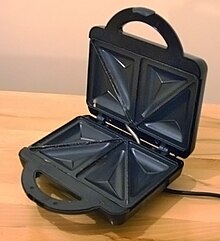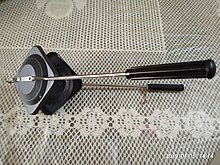This article has multiple issues. Please help improve it or discuss these issues on the talk page. (Learn how and when to remove these messages)
|


A pie iron, also called pudgy pie iron, sandwich toaster, snackwicher, toastie maker, sandwich maker, is a cooking appliance that consists of two hinged concave, round or square, cast iron or aluminium plates on long handles. Its "clamshell" design resembles that of a waffle iron, but without the checkered pattern. Pie irons are used to heat, toast and seal the sandwich.
Name
The most common type in most countries are electrically heated counter-top models, and names vary from place to place. In the United Kingdom, the pie iron is referred to as a "toastie maker" or "toasted sandwich maker".
Origins
In the U.S., the Tostwich is possibly the earliest toasted sandwich maker, dating back to before 1920. However, it was not patented until 3 March 1925 (applied for on 26 May 1924). It was invented by Charles Kozak, whose other inventions include a corn-popping machine for the mass production of popcorn.
Operation
Modern versions of the pie-iron are commonly more domestic, if not necessarily more refined, with subdivisions allowing pairs of bread slices to be clamped together around fillings to form pockets or stuffed sandwiches. A combination of heat and pressure seals the bread at the outer edges.

Campfire versions are still made of cast iron and can be cooked over coals, open flames, or a stove, but lightweight aluminium stove-top versions are made, generally being coated with a non-stick surface (PTFE) both as a cleaning aid and to allay fears regarding aluminium in the diet. PFAs
Once the device is hot, the sandwich can be assembled "inside-out", where the buttered side of the bread faces outwards against the metal plates and the filling sits inside. This produces a crunchier sandwich and helps prevent the bread from sticking. Alternatively, bread can be placed inside unbuttered, which produces a chewier sandwich.
Regional variants

In 1949, in Australia, the original Jaffle brand jaffle iron, to be heated over a fire, was designed and patented by Surfoplane inventor, Dr Ernest Eric Smithers from Bondi, Australia.
In 1974, Cuisinart made an Australian electric jaffle iron. Rights acquired by John O'Brien for Australian cookware company Breville in the 1970s mean that the name Breville is sometimes used there eponymously to describe both the device and the toasted, sealed sandwich product.
In the UK, the appliance is notorious for being little-used. A survey in 2005 suggested that 45% of British adults own, but do not use, sandwich toasters.
In India, open flame toasters are used to toast sandwiches. They are often called "Bombay sandwiches" in Mumbai. A similar American utensil is trademarked "Toas-Tite".
A "Jaffle" is another variant in Australia. The original Jaffle brand jaffle iron only sealed the sandwich around the edges, and did not cut it in half. This allowed more filling and or a whole egg. However, since the introduction of the Breville Snack'n'Sandwich Toaster in 1974, most electric jaffle makers in Australia split the sandwich in half.
See also
References
- "Catlin's Own Inventor", Shirley Nesbitt, 2000, accessed 26 December 2007
- ^ "Toasted sandwich; Butter the outside or not?". Piston Heads. 2015. Retrieved 19 October 2017.
- "A Paipo Interview with John Ruffels". mypaipoboards.org. Retrieved 9 October 2024.
- "Surfoplane surf mat". collections.sea.museum. Retrieved 9 October 2024.
- "The Advent of the Surfoplane phenomenon on our beaches led to an increase in lifesavers responses, a fatality, along with lives being saved". pittwateronlinenews.com – Pittwater Online News. 30 October 2022. Retrieved 8 October 2024.
Issue 560
- "1949 Jaffle craze hits Australia". Australian food history timeline. 18 September 1940. Retrieved 25 November 2020.
- Leigh, Wendy (5 October 2024). "Why Australian Grilled Cheese Is Called A Jaffle". Tasting Table. Retrieved 8 October 2024.
- "From the Vault: Toasted Sandwich Maker". The New Inventors. ABC Television. Retrieved 16 May 2011.
- "The Original 4-Slice". Breville Product Information. Retrieved 16 May 2011.
- "£9bn wasted on unused gadgets for our homes". The Daily Telegraph. Retrieved 28 June 2023.
- "Is the Bombay Sandwich really from Mumbai?". Condé Nast Traveller. July 2020.
- Fabricant, Florence (14 February 2012). "The Return of the Toas-Tite". The New York Times. p. D6.
- O’Connell, Jan. "1949 Jaffle craze hits Australia". Australian Food Timeline. Retrieved 18 March 2024.
- O’Connell, Jan. "1974 Breville Snack'n'Sandwich Toaster". Australian Food Timeline. Retrieved 18 March 2024.